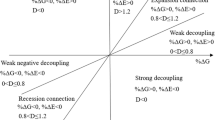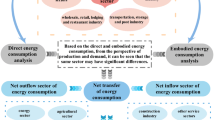Abstract
From the perspective of supply chain, energy consumption is an aggregation of energy intensity, intermediate input ratio, and final demand. However, research on the role of intermediate input on energy consumption is rare. This paper disaggregates the complete demand model of China based on MRIO (multi-region input-output model) into final demands and intermediate demands, and applied a decomposition approach combining LMDI (logarithmic mean Divisia index) and SDA (structural decomposition analysis) to evaluate the contribution of intermediate intensity, integrating the respective advantages of SDA and LMDI. The results show that both domestic and international intermediated intensities promote China’s energy consumption growth in most years. The reasons are as follows: (1) the intermediate efficiency enhanced; (2) the final consumption structure shifted toward the more complex pattern; (3) the market demanded more energy-intensive final goods. All effects are positive except the energy intensity effect. Based on the consistency in aggregation of LMDI, we found that the aggregation of international effects is bigger than the aggregation of domestic effects, illustrating that international factors are the main driving force of China’s energy consumption. The research implies that the intermediate process deserves more attention for the mitigation of energy consumption and greenhouse gas emissions. Improvement of intermediate efficiency and structure will be effective.










Similar content being viewed by others
References
Ang BW, Liu FL (2001) A new energy decomposition method: perfect in decomposition and consistent in aggregation. Energy 26(6):537–548
Cansino JM, Roman R, Ordonez M (2016) Main drivers of changes in CO2 emissions in the Spanish economy: a structural decomposition analysis. Energy Policy 89:150–159
Cao Z, Wei J (2019) Industrial distribution and LMDI decomposition of trade-embodied CO2 in China. Dev Econ 57(3):211–232
Cherni J, Kentish J (2007) Renewable energy policy and electricity market reforms in China. Energy Policy 35(7):3616–3629
de Araújo IF, Jackson RW, Neto ABF, Perobelli FS (2020) European union membership and CO2 emissions: a structural decomposition analysis. Struct Change Econ D 55:190–203
Deng G, Ding Y, Ren S (2016) The study on the air pollutants embodied in goods for consumption and trade in China–accounting and structural decomposition analysis. J Clean Prod 135:332–341
Dietzenbacher E, Los B (1998) Structural decomposition techniques: sense and sensitivity. Econ Syst Res 10(4):307–324
Feng K, Siu YL, Guan D, Hubacek K (2012) Analyzing drivers of regional carbon dioxide emissions for China: a structural decomposition analysis. J Ind Ecol 16(4):600–611
Hoekstra R, van der Bergh J (2003) Comparing structural and index decomposition analysis [J]. Energy Econ 25(1):39–64
Jia N, Gao X, Liu D, Shi J, Jiang M (2019) Identification and evolution of critical betweenness sectors and transactions from the view of CO2 reduction in supply chain network. J Clean Prod 232:163–173
Koopman R, Wang Z, Wei SJ (2014) Tracing value-added and double counting in gross exports. Am Econ Rev 104(2):459–494
Liu LC, Fan Y, Wu G, Wei YM (2007) Using LMDI method to analyze the change of China’s industrial CO2 emissions from final fuel use: an empirical analysis. Energy Policy 35(11):5892–5900
Liu LC, Wu G, Wang JN, Wei YM (2011) China’s carbon emissions from urban and rural households during 1992–2007. J Clean Prod 19(15):1754–1762
Liu H, Polenske KR, Guilhoto JJM, Xi Y (2014) Direct and indirect energy use in China and the United States. Energy 71:414–420
Meng B, Peters GP, Wang Z, Li M (2018a) Tracing CO2 emissions in global value chains. Energy Econ 73:24–42
Meng J, Zhang Z, Mi Z, Anadon LD, Zheng H, Zhang B, Shan Y, Guan D (2018b) The role of intermediate trade in the change of carbon flows within China. Energy Econ 76:303–312
National Bureau of Statistics of China (NBSC) (1998–2020) Chinese energy statistics yearbook. China Statistics, Beijing
Peng S, Zhang W, Sun C (2016) ‘Environmental load displacement’ from the North to the South: a consumption-based perspective with a focus on China. Ecol Econ 128:147–158
Peters GP (2008) From production-based to consumption-based national emission inventories. Ecol Econ 65(1):13–23
Shi J, Li H, An H, Guan J (2019) Tracing carbon emissions embodied in 2012 Chinese supply chains. J Clean Prod 226:28–36
Su B, Ang BW (2011) Multi-region input–output analysis of CO2 emissions embodied in trade: the feedback effects. Ecol Econ 71:42–53
Su B, Ang BW, Li Y (2017) Input-output and structural decomposition analysis of Singapore’s carbon emissions. Energy Policy 105:484–492
Sun X, Liu X (2020) Decomposition analysis of debt’s impact on China’s energy consumption. Energy Policy 146:111802
Sun X, An H, Gao X, Jia X, Liu X (2016) Indirect energy flow between industrial sectors in China: a complex network approach. Energy 94:195–205
Wachsmann U, Wood R, Lenzen M, Schaeffer R (2009) Structural decomposition of energy use in Brazil from 1970 to 1996. Appl Energy 86(4):578–587
Wang H, Ang BW (2018) Assessing the role of international trade in global CO2 emissions: an index decomposition analysis approach. Appl Energy 218:146–158
Wang M, Feng C (2018) Using an extended logarithmic mean Divisia index approach to assess the roles of economic factors on industrial CO2 emissions of China. Energy Econ 76:101–114
Wang M, Feng C (2019) Decoupling economic growth from carbon dioxide emissions in China’s metal industrial sectors: a technological and efficiency perspective. Sci Total Environ 691:1173–1181
Wang M, Feng C (2021) The consequences of industrial restructuring, regional balanced development, and market-oriented reform for China’s carbon dioxide emissions: a multi-tier meta-frontier DEA-based decomposition analysis. Technol Forecast Soc 164:120507
Wang P, Wu W, Zhu B, Wei Y (2013) Examining the impact factors of energy-related CO2 emissions using the STIRPAT model in Guangdong Province, China. Appl Energy 106:65–71
Wang H, Ang BW, Su B (2017a) Assessing drivers of economy-wide energy use and emissions: IDA versus SDA. Energy Policy 107:585–599
Wang Z, Wei SJ, Yu X, Zhu K (2017b) Characterizing global and regional manufacturing value chains: stable and evolving features. Centro Studi Luca d'Agliano Dev Stud Working Paper 419
Wang J, Wan G, Wang C (2019a) Participation in GVCs and CO2 emissions. Energy Econ 84:104561
Wang S, Zhu X, Song D, Wen Z, Chen B, Feng K (2019b) Drivers of CO2 emissions from power generation in China based on modified structural decomposition analysis. J Clean Prod 220:1143–1155
Xu Y, Dietzenbacher E (2014) A structural decomposition analysis of the emissions embodied in trade. Ecol Econ 101:10–20
Xu SC, He ZX, Long RY (2014) Factors that influence carbon emissions due to energy consumption in China: decomposition analysis using LMDI. Appl Energy 127:182–193
Xu H, Zhao G, Xie R, Zhu K (2020) A trade-related CO2 emissions and its composition: evidence from China. J Environ Manag 270:110893
Yan J, Shamim T, Chou SK, Desideri U, Li H (2017) Clean, efficient and affordable energy for a sustainable future. Appl Energy 185:953–962
Yan B, Duan Y, Wang S (2020) China’s emissions embodied in exports: how regional and trade heterogeneity matter. Energy Econ 87:104479
Zhang YJ, Bian XJ, Tan W, Song J (2017a) The indirect energy consumption and CO2 emission caused by household consumption in China: an analysis based on the input–output method. J Clean Prod 163:69–83
Zhang Z, Zhu K, Hewings GJD (2017b) A multi-regional input–output analysis of the pollution haven hypothesis from the perspective of global production fragmentation. Energy Econ 64:13–23
Zhao G, Liu C (2020) Carbon emission intensity embodied in trade and its driving factors from the perspective of global value chain. Environ Sci Pollut Res 27(2):1–14
Acknowledgements
We thank the reviewers for their valuable comments and suggestions.
Availability of data and materials
The datasets supporting the results of this article are included within the article.
Funding
This work is funded by the postdoctoral innovation program of Chinese Academy of Social Sciences, the Advanced Institute Research Program of University of Chinese Academy of Social Sciences and the Research Center of Enterprise Decision Support, Key Research Institute of Humanities and Social Sciences in Universities of Hubei Province [No.DSS20210401].
Author information
Authors and Affiliations
Contributions
Z. Liu did the decomposition analysis and was a major contributor in writing the manuscript. X. Huang came up with this research idea and provided a lot of work for the revision of the paper. M. Li constructed the “Introduction” section. X. Ma analyzed existing literatures and contributed to the discussions. All the authors read and approved the final manuscript.
Corresponding author
Ethics declarations
Ethics approval and consent to participate
Not applicable
Consent for publication
Not applicable
Competing interests
The authors declare no competing interests.
Additional information
Responsible Editor: Roula Inglesi-Lotz
Publisher’s note
Springer Nature remains neutral with regard to jurisdictional claims in published maps and institutional affiliations.
Rights and permissions
About this article
Cite this article
Liu, Z., Huang, X., Li, M. et al. The role of intermediate products in the changes of China’s energy use: index decomposition of the MRIO model. Environ Sci Pollut Res 28, 48481–48493 (2021). https://doi.org/10.1007/s11356-021-14041-y
Received:
Accepted:
Published:
Issue Date:
DOI: https://doi.org/10.1007/s11356-021-14041-y




